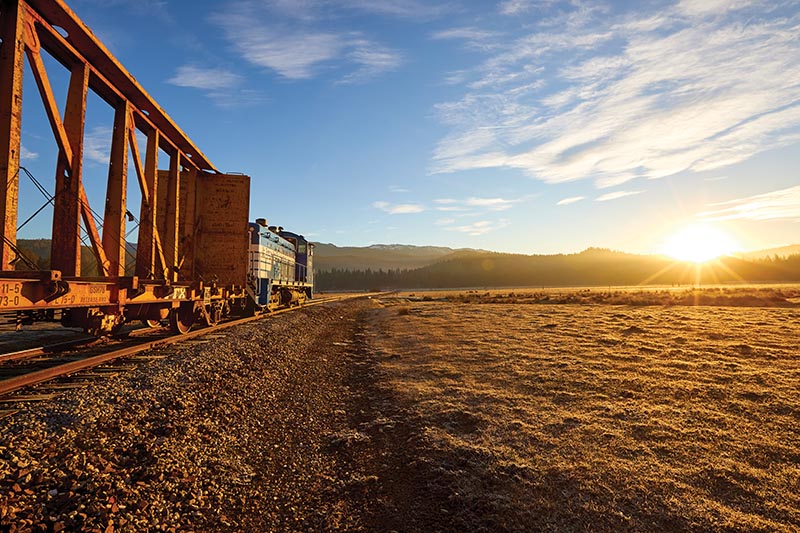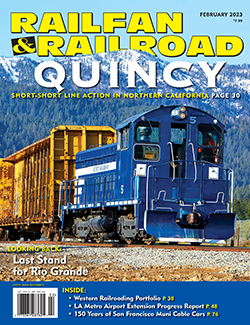 by Adam Weidenbach/photos by the author
by Adam Weidenbach/photos by the author
High in the American Valley of the Sierra Nevada is a very short short line railroad. For more than 100 years this tiny railroad has weathered changing times, changing markets, and changing ownerships. Today, the sole reason Quincy Railroad exists is for hauling lumber through beautiful meadows and forests from the huge Sierra Pacific Industries lumber mill in Quincy, Calif., to the junction with Union Pacific’s Canyon Subdivision. The run from the big SPI mill to Quincy Junction is a scant 2.75 miles, but this little lumber hauler has one of the steepest grades in the west to contend with, and is packed with charm and personality. When I jokingly ask myself just how many ways can you shoot a short line, Quincy Railroad keeps surprising me with the answer.
History
When Western Pacific built its famous line over the Sierra Nevada through the Feather River Canyon, it bypassed Quincy. To maintain its easy 1 percent grade, the line was built up along the side of Mount Hough about two miles north of Quincy, the seat of Plumas County. With only wagon roads that turned into a muddy mess in winter, the town felt it desperately needed a railroad to keep businesses from leaving. Promoters from San Francisco got wind of this and came to Quincy to convince locals to subscribe to building a new connecting railroad. Promoter J.J. Rutledge got $55,000 in contributions with the promise of matching those funds and building the railroad. Thus, on July 8, 1908, Quincy & Eastern Railroad was formed. However, it soon became clear that the promoters could not produce their share of the funding; Q&E was quickly dissolved and the big city promoters were run out of town.
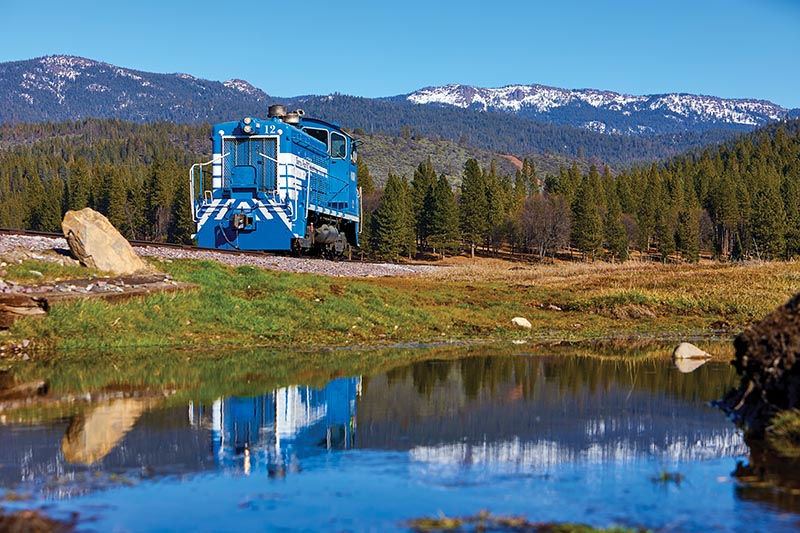
ABOVE: Quincy 12 glides back across the meadows to the mill after running to the junction with loads on February 9, 2022.
The town fathers, including H. Flourney and Arthur Keddie (who surveyed WP’s line over the Sierra Nevada), along with other prominent townsfolk, formed their own railroad, naming it Quincy & Western and incorporating it October 1, 1909. Q&W was built from its WP connection at Hartwell (milepost 228), later called Marston and renamed Quincy Junction in 1915, running steeply down along the lower flank of Mount Hough to the valley floor, where it crossed Greenhorn Creek and then ran across a beautiful mountain meadow on a slight uphill grade to East Quincy. It then turned westward and ran along Lee Road and into Quincy. The grade down the “hill” starts at 3 percent, then runs for about 1.5 miles on grades up to 4 percent. Nearing the bottom of the hill, the line runs through a cut and S-curve near Pine Oak Road. In the cut, a short drop reaching more than 5 percent is found.
The “Quick & Windy,” as it soon became known, was 5.38 miles long and had its depot and engine facilities near downtown. Construction began in April 1910 with 50-pound relay rail as old as 1875, salvaged from Southern Pacific’s line from Red Bluff to Woodland, Calif. At 11:30am on June 2, 1910, railroad Vice President L.N. Peter drove the final spike. After speeches by Peter and Keddie, free rides were offered to the public. By late fall, the railroad was completed with ballast, a depot, and a single-stall enginehouse for a cost of $72,000. Quincy & Western’s only locomotive was a 37-ton, 0-4-4T Forney-type built by American Locomotive Co. in December 1909 and numbered 1.
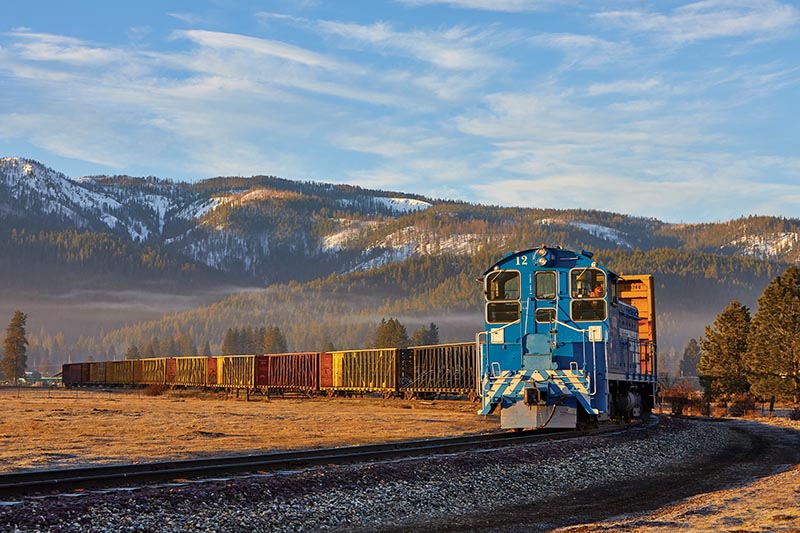
ABOVE: On the beautiful, sub-freezing, winter morning of February 10, 2022, the QRR crew pulls cars out of the siding to dig out one bad order car.
Hauling a modest amount of passengers and general freight, Q&W wasn’t exactly a financial success in the early years. By mid-1917, the railroad’s major stockholders had reached the end of their rope and advised local stockholders that the pike was all but finished. At this point, freight consisted of outbound shipments from one local lumber mill and a few inbound loads per month including less-than-carload freight, fuel, and general commodities. On September 17, Q&W filed with the State Railroad Commission for abandonment.
Objections from townsfolk and Quincy Lumber Co. came almost immediately. By mid-October, F.S. Murphy and James Ingebritzen of Quincy Lumber came to an agreement with the Q&W stockholders to buy the railroad. Articles of incorporation were filed on November 10, 1917, and the railroad was reorganized as Quincy Railroad. Shortly after, the lumber company was renamed the F.S. Murphy Lumber Co. To cut costs, the new owners purchased a gasoline-powered railway motorcar to carry passengers, baggage, and express. The “Galloping Goose,” as it was nicknamed, arrived in March 1918. The stinky new contraption weighed seven tons and could haul 25 passengers.
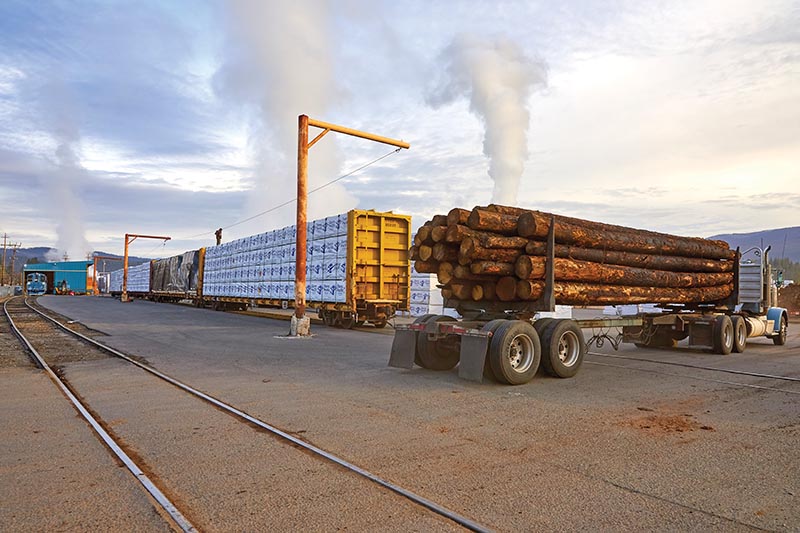
ABOVE: One of the nearly 300 log trucks per day enters the big SPI mill on May 12, 2022. The loading crew is busy tying down the cables on the last few lumber loads before the railroaders start up the locomotive for the day.
Sharing the track with the daily freight train proved to be risky business a few years later, when the train crew decided they could make a run for the junction before the Quincy-bound “downhill” motorcar departed. Of course, they failed to call in with their intentions and a “cornfield” meet occurred just as the Goose came out of the trees at the bottom of the hill near Chandler Road. Both crews “joined the birds,” leaving the lone passenger to fend for herself. Thankfully, the train crew dynamited the train’s brakes and the collision was at a slow speed, with the passenger sustaining only minor injuries.
The Murphy interests added a second locomotive in 1924 in anticipation of a sharp increase in traffic, due to Feather River Power Co. commencing the Bucks Creek Hydroelectric Project west of Quincy. Built by Alco in December 1924, 2-6-2T Number 2 weighed in at just under 60 tons. Between 1925 and 1928, QRR had a huge boost in revenue hauling inbound loads of construction supplies and heavy equipment for use on the dam project, including a Marion steam shovel weighing 221,000 pounds…


